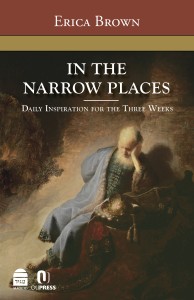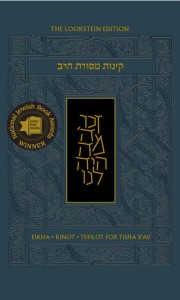Excerpted from Rabbi David Brofsky’s Hilchot Tefillah: A Comprehensive Guide to the Laws of Daily Prayer Click here to buy the book
Preparations for Tefillah
The Sages teach that one should prepare oneself, both physically and spiritually, for prayer. One’s appearance and attire should be appropriate for an encounter with God; in addition, one should mentally and spiritually prepare for such a meeting. One should also limit certain activities before praying, in order to emphasize the centrality and significance of prayer in one’s daily religious routine.
Proper Attire
The Gemara (Shabbat 10a) relates that certain Amoraim interpreted the verse hikon likrat elokecha — “Prepare to meet your God” (Amos 4:12) — as instructive, teaching us to prepare ourselves before encountering God.
Rabba son of R. Huna put on stockings and prayed, quoting, “Prepare to meet your God” [Amos 4:12]. Rabba removed his cloak, clasped his hands and prayed, saying, “[I pray] like a slave before his master.”
Similarly, the Rambam (Hilkhot Tefillah 5:5) writes:
How should one prepare his clothes? First, one should adjust one’s clothes, and distinguish and beautify oneself, as it says “You should prostrate yourselves to His holiness in beauty.” One should not stand for Tefillah in an undergarment, with a bare head, or with bare feet, if the local custom is to appear before important people with shoes… The ways of the wise and their students is to pray while they are wrapped [atufin] in a tallit.
The Kitzur Shulchan Arukh (12:1) adds that even one who prays alone in one’s house should dress appropriately.
The Rishonim and Acharonim discuss whether one is merely required to dress as one would dress when meeting an important person, or whether one should do something extra, such as wearing a special belt, or gartel.
This question arises from different understandings of the Talmud’s position regarding wearing a belt during prayer. On the one hand, the Gemara (Berakhot 24b) teaches:
R. Huna said: If a man’s garment is girded round his waist he may recite the Shema. It has been taught similarly: If his garment, whether of cloth or of leather or of sacking, is girded round his waist, he may recite the Shema, but he may not say the Tefillah [Shemoneh Esreh] until he covers his chest.
Apparently, the Gemara requires that one wear a belt in order to create a demarcation between one’s chest and one’s lower body. Seemingly, standing before God in prayer without this demarcation is viewed as inappropriate.
Another Gemara (Shabbat 10a), however, relates:
R. Sheshet demurred: Is it any trouble to remove the girdle [before prayer]! Moreover, let him stand thus [ungirdled] and pray!? — Because it is said, “Prepare to meet your God.”
According to this source, wearing a belt is an expression of preparing to encounter God in prayer.
The above two passages seem to disagree regarding whether one wears a belt in order to separate one’s upper and lower body during prayer, or whether it serves as an additional gesture in preparation for prayer.
Subsequently, the Rishonim debate whether one who does not ordinarily wear a belt must wear one for Shemoneh Esreh. e Ran (Shabbat 4a s.v. u-meha) and the Hagahot Maimoniyyot (Hilkhot Tefillah 5:8) insist that even one who wears pants must wear a belt for the Shemoneh Esreh. On the other hand, Rabbeinu Yerucham writes that only one who is accustomed to wearing a belt daily must wear a belt for Shemoneh Esreh. Seemingly, these opinions disagree as to whether one’s attire for prayer should match, or should exceed, one’s usual standard.
R. Simcha of Vitry, a student of Rashi, records that Rashi would pray without a belt. When questioned about this practice, he responded that the Amoraim’s clothing was similar to our robes, without any demarcation between the upper and lower body. Nowadays, he explained, since it is customary to wear pants, no further separation is required. Rashi, apparently, viewed this halakhah in the context of the requirement to demarcate one’s chest from one’s lower body. Apparently, Rashi did not believe that one must wear a belt to fulfill hikon, preparing to greet God, either because he holds that separating between the upper and lower body fulfills this obligation, or because he believes that one fulfils the obligation through other preparations, such as netilat yadayim.
The Shulchan Arukh (91:1–2) cites both reasons for wearing a belt, in order to demarcate between one’s upper and lower body, and in order to prepare properly for Tefillah. The Magen Avraham (1) and Mishnah Berurah (4), however, cite Rabbeinu Yerucham, who states that only one who normally wears a belt must wear one for Tefillah, but that one who does not ordinarily wear a belt need not wear one for Tefillah. The Mishnah Berurah does add, however, that there may still be a middat chasidut in wearing a belt. In addition, the Mishnah Berurah (5) cites the Zohar, which states that it is appropriate to cover one’s head with a tallit during Shemoneh Esreh.
In modern times, some authorities have revisited this issue, questioning the propriety of wearing short sleeves, or even shorts, during prayer (see R. Ovadyah Yosef in Yechavveh Da’at 4:8). The Shulchan Arukh (90:5), for example, writes “One should not stand up for prayer… with exposed feet, if the accepted practice is to greet important people with shoes.” The Mishnah Berurah (91:11–13) points out that in hot countries where it is customary to stand before important people barefooted, one need not be concerned even if one is wearing “short clothing through which the legs are visible.” He also writes that one should not pray in sleepwear (pajamas), or other clothing that one would not wear to greet “important people.”
The Proper Place in Which to Pray
In Chapters 10 and 11 we discussed those places in which one should not pray, due to the presence of foul odors or substances, or because of the presence of ervah. However, the Gemara also enumerates places in which it may be preferable to pray, whether because of the holiness of the place or because of the effect of the environment on one’s kavvanah.
Chazal strongly suggest praying in a beit kenesset. To begin with, one can usually join a minyan in a beit kenesset, thus participating in tefillah be-tzibbur. Prayer with a minyan affords one the opportunity to hear devarim she-bikedushah (Kaddish, Kedushah, etc). In addition, prayer offered by the community is qualitatively different, and maybe even more “effective” than individual prayer.
In addition, the Rabbis also teach (Berakhot 6a):
A person’s prayer is heard [by God] only in the synagogue… Rabin bar R. Adda says in the name of R. Yitzchak: How do you know that the Holy One, blessed be He, is to be found in the synagogue? For it is said: “God stands in the congregation of God” [Tehillim 82:1].
The Shulchan Arukh (90:9) rules that even if one must pray without a minyan, it is still preferable to pray in a beit ha-kenesset. In addition, the Gemara (Berakhot 6b) teaches that one should preferably pray in a fixed place:
R. Chelbo, in the name of R. Huna, says: Whosoever has a fixed place for his prayer has the God of Avraham as his helper. And when he dies, people will say of him: Where is the pious man, where is the humble man, one of the disciples of our father Avraham! How do we know that our father Avraham had a fixed place [for his prayer]? For it is written: “And Avraham got up early in the morning to the place where he had stood” [Bereishit 26:7]. And “standing” means nothing else but prayer. For it is said: “Then stood up Pinchas and prayed” [Tehillim 106:30].
The Shulchan Arukh (90:19) rules accordingly, and the Mishnah Berurah adds (59) that even when one prays in one’s house, one should preferably designate a specific place for prayer.
Finally, the Gemara (Berakhot 34b) also teaches:
R. Chiyya bar Abba said in the name of R. Yochanan: A person should only pray in a house with windows, as it says: “And the windows of his upper chamber were open toward Jerusalem” [Daniel 6:11]. R. Kahana says: A person who prays in a valley is brazen.
The commentators disagree as to why one should pray in a room with windows.
Rashi explains that “the [windows] cause him to direct his prayers, to focus one’s thoughts to the heavens, and his heart is humbled.”
The Talmidei Rabbeinu Yonah (24b) also explain that the outside light will help “settle his thoughts”, allowing him to pray with greater kavvanah.
The Talmidei Rabbeinu Yonah offer another interpretation. They suggest that the windows should be open towards the east, towards Jerusalem, and “through gazing in this direction he will direct his prayers more accurately towards God, and his prayer will be desirable and accepted.”
R. Avraham Yitzchak Ha-Kohen Kook (1865–1935), in his commentary on the aggadic sections of the Talmud, Ain Aiyah, provides a further explanation as to why one should pray in a room with windows:
Prayer is an intensely introspective activity, but it should not lead us to belittle the value of being part of the world around us. If meditation and private prayer lead us to break our ties with the outside world, then we have missed the highest goal of prayer… For this reason, the Sages taught that the room in which we pray should have windows, thus indicating our ties and moral obligations to the greater world.
Prayer, by its very definition, must face outwards, relating to the broader world and its needs and concerns.
With regard to Chazal’s objection to praying in an open valley, Rashi explains that an enclosed, modest place is more conducive to feeling fear of God. Interestingly, Tosafot (s.v. chatzif) ask why Yitzchak went out to the field to converse with God (Bereishit 24). They suggest that Yitzchak prayed on Har Ha-Moriah, implying that at times the sanctity of a place may override the injunction to pray in an enclosed area. This is certainly relevant to those who pray at the Kotel Ha-Ma’aravi. They add that the Gemara refers to a “valley” through which many people traverse. Seemingly, according to Tosafot, it is difficult to concentrate in such a valley, due to the ongoing traffic of people.
The Mishnah Berurah (90:11–12) writes that one may pray in a place which is enclosed, even if there is no roof. He then cites the Zohar, however, which writes that one should always pray in a “house” (with a roof).






